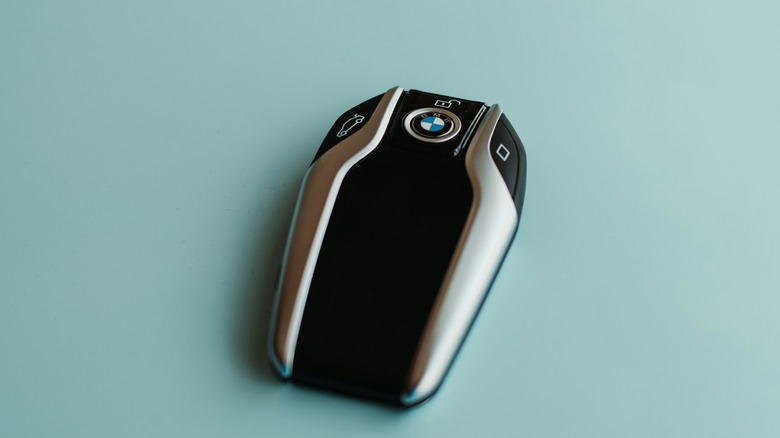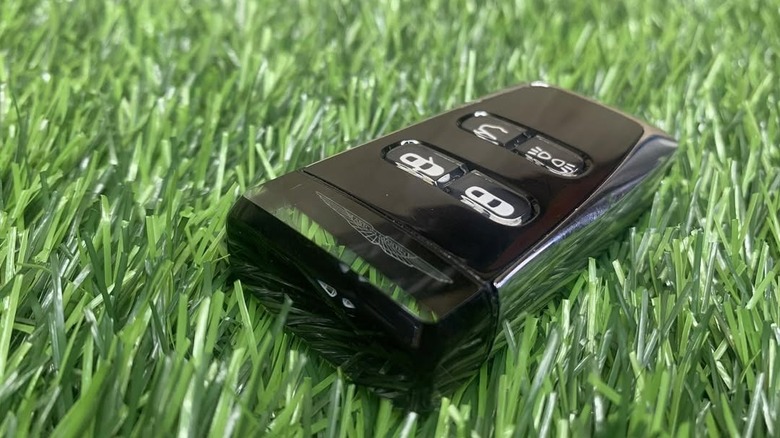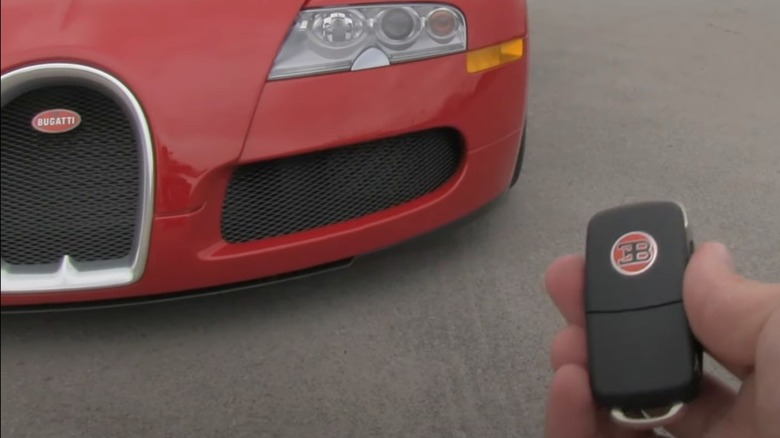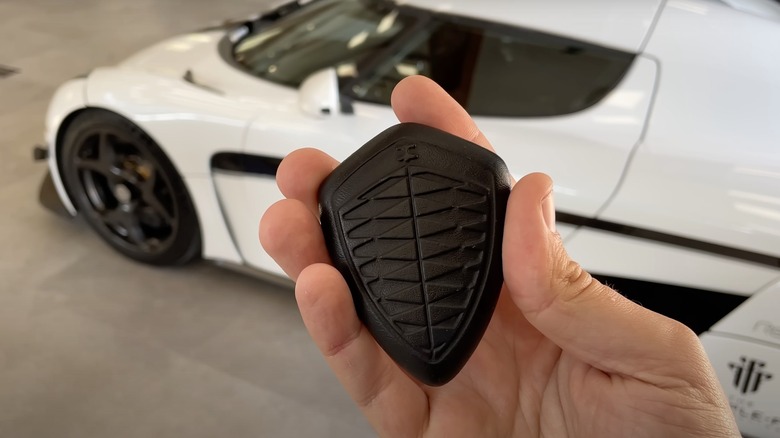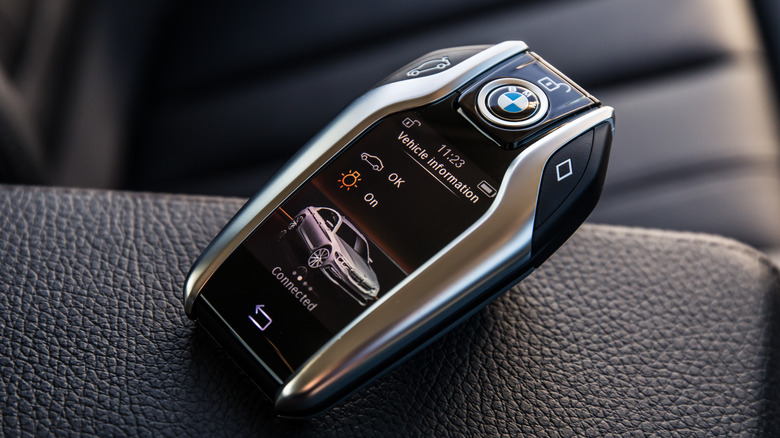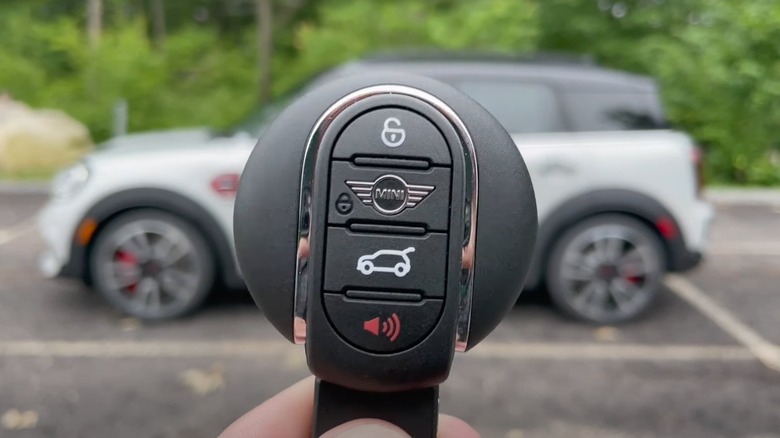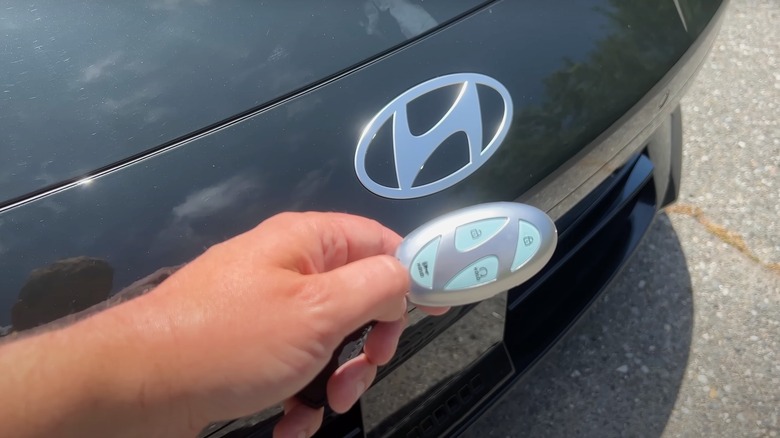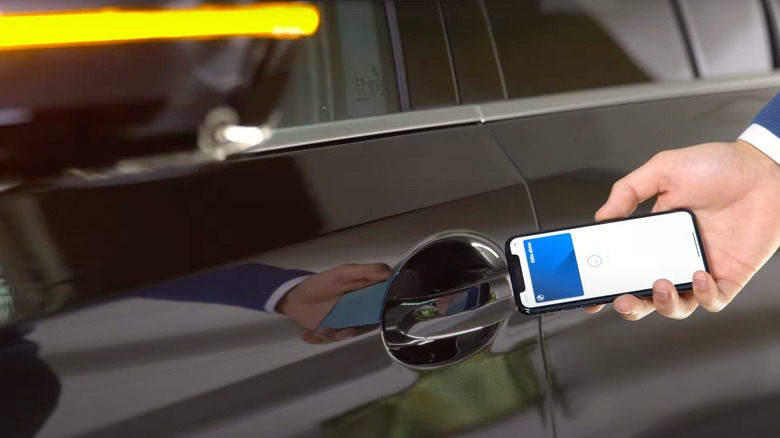The Best (And Worst) Car Keys Ever Made
It's almost hard to believe that at one point, cars didn't have keys. Keys didn't become a thing until the 1910s, when automakers implemented them as a minor safety measure to prevent potential thieves from starting the engine. It's also fascinating that before 1949, cars used push-button starters. Then Chrysler introduced the ignition key that would crank the engine to life, and now we have returned to push-button starting.
Over 110 years later, car keys have become a bit more involved. They often have interesting designs and integrate a lot of functions that you can get to before you even get in the car. Some modern cars have moved past little remotes, instead placing the key within an app on your phone or smartwatch. We've seen tons of car key designs over the years, some of them really cool, some of them not so cool, and some of them that seriously leave us scratching our heads.
Best: Aston Martin Crystal Key
Some 20 years ago, Aston Martin was part of Ford's Premier Automotive Group. This meant, among other things, a remote key fob borrowed directly from Volvo. In 2000s Aston models, you had a cool glass starter button in the center control stack that allowed your V8 or V12 to roar to life. As the decade drew to a close, Aston Martin had a better idea. By the late 2000s, most Aston Martin vehicles would get a crystal key. This didn't include an actual key blade; it was simply a remote fob. The bottom of the key featured the Aston Martin wings encased in super-durable and super-expensive crystal sapphire. The key was so special, Aston Martin decided to give it its own (ridiculous) name: the Emotion Control Unit.
Because this era of Astons didn't have a classic ignition tumbler, you had to insert the crystal key into a slot in the dash, with the logo the right way up, and hold it in to start. While you were driving, the Aston Martin logo would always be there, just to remind you how cool you are.
Worst: Bugatti Veyron Key
When Volkswagen bought out Bugatti, it decided to use the brand to create the fastest production car in the world. Notably, Top Gear wasn't having any of it, but then, Bugatti only went and did it: the Veyron really became the fastest production car in the world for quite some time, topping out at 253 mph.
The Veyron also had 1,000 hp courtesy of its quad-turbocharged W16 engine, and it cost a whole lot of money when it was new. Such a special car would require a special key to enter and start, wouldn't you think? Well, not quite. Even though Volkswagen-owned Bugatti dumped insane amounts of money into the Veyron project, the key fob was one area where it simply couldn't spend the extra money — at least, not for the spare one. On early Veyron models, the spare key is exactly the same as any Volkswagen product from the 2000s, like the Golf, the Jetta, or even a Skoda or Seat. This is why a lot of Volkswagen owners (myself, both a former and current VW owner, included) joke that their key fobs are to their Bugattis.
Best: Koenigsegg Crest Key
You'll often hear about a lot of car manufacturers that they always pay close attention to detail, but no other manufacturer that lives up to this reputation more than Koenigsegg. The Swedish megacar maker, which still builds its cars in Sweden, has proudly made almost every single component in-house for a while now, and all of its cars are crammed full of stuff you just don't get in any other car, hyper or otherwise.
As you'd expect, a car of this caliber would require a special key, and Koenigsegg paid close attention to that, as well. The entire key fob is shaped like the Koenigsegg crest, and depending on the model, the other side of the key contains your basic functions, but in some, it goes deeper. The Regera, for example, features buttons to open and close the doors automatically, along with the front panel and the engine cover, since they're all on hydraulics. What's more, the key itself is made of solid metal, and some Koenigsegg models even give you a perfectly sized and shaped slot to place the key while you're driving.
Worst: BMW Display Key
We already mentioned that a lot of modern cars have totally skipped out on actual key fobs, opting instead to place all of those functionalities inside an app you download on your phone or watch. A few years ago, this wasn't really happening in the car industry, but someone at BMW had a great idea.
The automaker decided to give some models the option of a huge key fob with a built-in display that could show certain stats and functionalities. This was commonly seen on models like the previous-generation 7 Series and the i8 sports car. It sounds cool in theory, but the execution wasn't exactly great. For one, this key is heavy and bulky, taking up significantly more space in your pocket than even the chunkiest of key fobs. The screen was also incredibly laggy, and for a lot of people, this option didn't really make much sense. BMW eventually abandoned the idea and returned to normal key fobs.
Best: Pagani Huayra Key
Predictably, we have another hypercar known for its incredible attention to detail. Recently, the Pagani Huayra raced off into the sunset, and while we're excited for its replacement, the Utopia, we can't shun the fact that the Huayra set a new standard for what the hypercar experience should feel like. This includes the key fob. Taking a page from Porsche and Tesla, the Huayra's key is shaped like the car itself. It's made of metal and split into two pieces, held together by a magnet. In early models without keyless start, you'd remove the front half and insert it into a slot in the center control stack to start the twin-turbo V12.
Pagani also, rather thoughtfully, included a spot to mount the front half of the key beside the parking brake: facing straight up, and looking seriously cool. On closer inspection, though, you'll notice the key inside the metal casing is straight off a late-2000s Mercedes. No surprise, the Huayra uses an AMG-derived V12, but what a great way to mask it. The only slight disappointment is that later Huayra models added a starter button, so there was no slot for the key. Shame, really.
Worst: Mini Key Fob
This does not apply to the latest generation of the iconic hatch, as Mini finally came to its senses and started including a fairly normal pill-shaped key fob. On the way from the regular key to this new fob, however, we had the dreaded circular key fob. Almost every Mini model from the R56 hatch to the previous-generation Countryman used a version of this device. It's shaped like a frisbee, but then it has a strange growth on the bottom so you can attach a keychain to it. You could easily forgive this, because it's tough not to be floored by the Mini's charm. Without rose-tinted glasses, though, this is just a silly design.
Later versions of this key placed the buttons in a more sensible area, i.e., in a vertical row on the back side. However, the earliest versions put the buttons around the perimeter of the disc. Plus, as I can personally tell you about these keys, the labels on them rub off. We love the Mini, we love its design, but we're glad this key fob was retired.
Best: Hyundai Logo Key
Finally, something that isn't from a multimillion-dollar hypercar. We are living in an era where normal cars that can be bought by a lot more people have really cool key fobs. Previously, Hyundai keys were a pretty lame affair. Some of you might remember those strange, thin remotes that were attached to a conventional key in the late 2000s and early 2010s.
A lot of recent Hyundai models have moved to something far more interesting, and also absolutely genius. The Hyundai logo is now also the key fob. It's oval-shaped, and the buttons and functions take up what would otherwise be empty space in the logo, specifically on the inside and around the letter H. If your Hyundai has the remote parking feature equipped, those buttons are on the side, while the face is taken up by the requisite lock, unlock, hatch/trunk release, and so on. This is a genius idea, and even though this key is still made of plastic, it's definitely much cooler than your standard boring black remote fob.
Worst: Smartphone / Digital Keys
It's time to face reality, people: Smartphone or digital keys are kind of a bad idea. First seen on the Tesla Model 3 a few years ago, this seemed like a pretty interesting solution to a minor but real problem — forgetting your key fob. You have your phone with you at all times, so why not put the key functions, along with a whole bunch of other features, inside a smartphone app? In Tesla's case, you can honk the horn, turn on the lights, check for any prying eyes if your car has Sentry Mode, and other such things.
If you want to let someone else drive the car, you either give them a normal key like the Ford Mustang Mach-E, or a thin card like the Volvo EX30 or, again, the Model 3. These are the benefits on paper. But what happens if your phone runs out of battery? While remote features may rely on data, unlocking and starting the car via the phone key works over Bluetooth, so it doesn't need a mobile connection. Still, for remote commands, you have to take your phone out, unlock it, open the app, wait for it to start, navigate to the command, and then tap on it — whereas for unlocking and driving, the phone key works passively in your pocket, like a keyless fob.
But really, what was wrong with just taking the key out and unlocking the door? Or even just walking up to the car and opening it, if it has keyless entry? Smartphone apps for your car can be useful, but moving all key functionalities to the app is not it.
